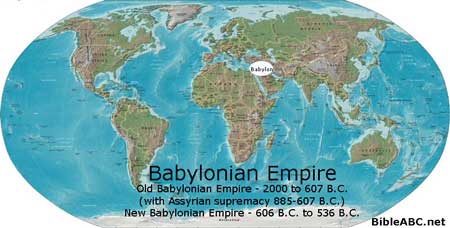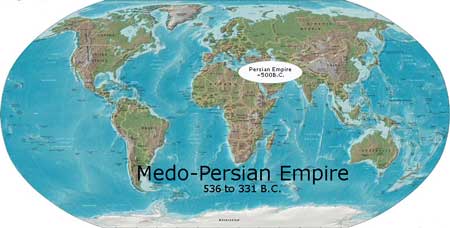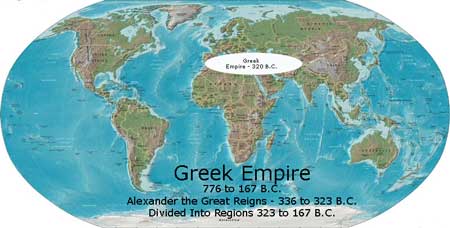 Correct. Correct.
 You are the head of gold. 39"After you
there will arise
another
kingdom inferior to you, then
another
third kingdom of bronze, which will rule over
all the earth. 40"Then there will
be a fourth
kingdom as strong as iron; inasmuch as iron
crushes and shatters all things, so, like iron that
breaks in pieces, it will crush and break all these
in pieces. 41"In that you saw the feet
and toes, partly of potter's clay and partly of
iron, it
will be a divided kingdom; but it will have
in it the toughness of iron, inasmuch as you saw the
iron mixed with common clay. 42"As the
toes of the feet were partly of iron and partly of
pottery, so some of the kingdom will be strong and
part of it will be brittle. 43"And in that you saw
the iron mixed with common clay, they will combine
with one another in the seed of men; but they will
not adhere to one another, even as iron does not
combine with pottery. Daniel
2:38-43 (NAS)
You are the head of gold. 39"After you
there will arise
another
kingdom inferior to you, then
another
third kingdom of bronze, which will rule over
all the earth. 40"Then there will
be a fourth
kingdom as strong as iron; inasmuch as iron
crushes and shatters all things, so, like iron that
breaks in pieces, it will crush and break all these
in pieces. 41"In that you saw the feet
and toes, partly of potter's clay and partly of
iron, it
will be a divided kingdom; but it will have
in it the toughness of iron, inasmuch as you saw the
iron mixed with common clay. 42"As the
toes of the feet were partly of iron and partly of
pottery, so some of the kingdom will be strong and
part of it will be brittle. 43"And in that you saw
the iron mixed with common clay, they will combine
with one another in the seed of men; but they will
not adhere to one another, even as iron does not
combine with pottery. Daniel
2:38-43 (NAS)

The Image in the Dream:
The head of gold was the king of Babylon and the
other sections of the image represented different
kingdoms to arise after Babylon:
1.
The Gold Head: The gold head represented the
king of Babylon.
2. The
Silver Chest: The silver chest and arms
(the 2nd section under the head) represents a
kingdom to arise after Babylon; this kingdom would
be inferior to Babylon. Daniel 5:28 and Daniel
8:20 identifies this 2nd kingdom as the Medes and
Persians.
3.
The Belly and Thighs of Brass: The
belly and thighs of brass (third section) would be a
third kingdom, which shall rule over all the earth.
Daniel chapter 8 identifies this third kingdom as
Greece (see Daniel 8:21).
4.
The Legs of Iron and the Feet of Iron and Clay:
The legs of iron (fourth section) would be a fourth
kingdom, a strong kingdom that will break in pieces
and crush other kingdoms. The feet of iron and clay
mean that it would be a divided kingdom, partly
strong and partly broken. Although it is not
specifically named, the last major empire to emerge
would be Rome.
The Empires:
Here is what you find from history if you look at
the major world empires that arose after Babylon:
 1.
Babylonian Empire: 1.
Babylonian Empire:
The Babylonian Empire was built primarily by the
efforts of Hammurabi (1728-1686
B.C.) and
Nebuchadnezzar II (604-562
B.C.). The Empire
declined with the fall of Nebuchadnezzar, fell to a
lower level under Belshazzer, and came to ruin when
Xerxes, the Persian King, destroyed it in 478
B.C.
2.
Medo-Persian Empire:
The Empire of the Medes and
 Persians
(the Medo-Persian Period) began with a man called
Deioces son of Phraortes" (around 715
B.C.) who
founded the Median kingdom and its capital city at
Ecbatana, which today is called Hamadan. It was probably not
before 625
B.C. that Cyaxares, grandson of Deioces,
succeeded in uniting into a kingdom the many
Iranian-speaking Median tribes. In 614 he captured
Ashur, and in 612, in alliance with Nabopolassar of
Babylon, his forces stormed Nineveh, putting an end
to the Assyrian empire. The victors divided the
Assyrian provinces among themselves, with the Median
king taking over a large part of Iran, northern
Assyria, and parts of Armenia. By the victory in 550
of the Persian chief Cyrus II the Great over his
suzerain, Astyages of Media, the Medes were made
subject to the Persians. The first prominent leader
of the Persians was the warrior chief Hakhamanish,
or Achaemenes, who lived about 681
B.C. The Persians
were dominated by the Medes until the accession to
the Persian throne in 550
B.C. of Cyrus the Great.
He overthrew the Median rulers, conquered the
kingdom of Lydia in 546
B.C. and that of Babylonia
in 539
B.C. and established the Persian Empire as
the preeminent power of the world. Darius I, who
ascended the throne in 521
B.C., pushed the Persian
borders as far eastward as the Indus River. From 499
to 493
B.C. he engaged in crushing a revolt of the
Ionian Greeks living under Persian rule in Asia, and
then launched a punitive campaign against the
European Greeks for supporting the rebels. His
forces were disastrously defeated by the Greeks at
the historic Battle of Marathon in 490B.C.. Darius
died while preparing a new expedition against the
Greeks; his son and successor, Xerxes I, attempted
to fulfill his plan but met defeat in the great sea
engagement, the Battle of Salamís, in 480
B.C. and in
two successive land battles in the following year.
The forays of Xerxes were the last notable attempt
at expansion of the Persian Empire. Many revolts
took place in the next century; the final blow was
struck by Alexander the Great, who added the Persian
Empire to his own Mediterranean realm by defeating
the troops of Darius III in a series of battles
between 334 and 331B.C.. Persians
(the Medo-Persian Period) began with a man called
Deioces son of Phraortes" (around 715
B.C.) who
founded the Median kingdom and its capital city at
Ecbatana, which today is called Hamadan. It was probably not
before 625
B.C. that Cyaxares, grandson of Deioces,
succeeded in uniting into a kingdom the many
Iranian-speaking Median tribes. In 614 he captured
Ashur, and in 612, in alliance with Nabopolassar of
Babylon, his forces stormed Nineveh, putting an end
to the Assyrian empire. The victors divided the
Assyrian provinces among themselves, with the Median
king taking over a large part of Iran, northern
Assyria, and parts of Armenia. By the victory in 550
of the Persian chief Cyrus II the Great over his
suzerain, Astyages of Media, the Medes were made
subject to the Persians. The first prominent leader
of the Persians was the warrior chief Hakhamanish,
or Achaemenes, who lived about 681
B.C. The Persians
were dominated by the Medes until the accession to
the Persian throne in 550
B.C. of Cyrus the Great.
He overthrew the Median rulers, conquered the
kingdom of Lydia in 546
B.C. and that of Babylonia
in 539
B.C. and established the Persian Empire as
the preeminent power of the world. Darius I, who
ascended the throne in 521
B.C., pushed the Persian
borders as far eastward as the Indus River. From 499
to 493
B.C. he engaged in crushing a revolt of the
Ionian Greeks living under Persian rule in Asia, and
then launched a punitive campaign against the
European Greeks for supporting the rebels. His
forces were disastrously defeated by the Greeks at
the historic Battle of Marathon in 490B.C.. Darius
died while preparing a new expedition against the
Greeks; his son and successor, Xerxes I, attempted
to fulfill his plan but met defeat in the great sea
engagement, the Battle of Salamís, in 480
B.C. and in
two successive land battles in the following year.
The forays of Xerxes were the last notable attempt
at expansion of the Persian Empire. Many revolts
took place in the next century; the final blow was
struck by Alexander the Great, who added the Persian
Empire to his own Mediterranean realm by defeating
the troops of Darius III in a series of battles
between 334 and 331B.C..
 3.
The Greek Empire: 3.
The Greek Empire:
Greek history is thought to have begun somewhere in
the 12th century
B.C. The first Greek Olympiad was
held in 776
B.C. The golden age of Greece was an era
of great statesmen, philosophers and dramatists in
the 5th century
B.C. Alexander the Great assumed
command of the Greek army in 336
B.C. and conquered
lands to the east that had formerly been under the
rule of Persia, Babylon, Assyria and Egypt.
Alexander the Great had conquered most of the known
world by 331
B.C. Alexander died in 323
B.C. and his
empire was divided among his four generals.
 4.
Roman Empire: 4.
Roman Empire:
The history of Rome began in 753
B.C. As late as 390
B.C., when Greece and Persia were great powers in
the world, Rome was still very weak. However, during
the 4th and 3d centuries
B.C., the Romans became
masters of central and southern Italy. Roman armies
entered Greece, where they were both conquerors and
conquered: they defeated the Greek armies, but they
were overawed by Greek culture and brought back to
Rome a taste for fine art and literature. In 202
B.C. at the Battle of Zama, Rome defeated Carthage.
During the next two centuries the Roman Empire
expanded rapidly, gobbling up many of the
territories once ruled by Alexander the Great,
including Greece, Asia Minor, Syria, and Egypt. In
60
B.C. a triumvirate (three-man executive board)
consisting of Gaius Julius Caesar, Pompey the Great,
and Marcus Licinius Crassus led Rome. In 44
B.C.
Caesar was murdered by a group of senators. The
empire he had founded, with its autocratic
tendencies, lasted long after his death. Imperial
Rome lasted from 44
B.C. until
A.D. 476. During the
first 3 centuries of imperial Rome, 50 emperors
occupied the throne, and 37 of them died violent
deaths. Rome's fall would come at the hands of
barbarian invaders. During the 2nd century
A.D.
Goths looted Greece and Asia Minor. During the 3rd
century
A.D. the Parthians reached Antioch. By the
5th century
A.D. the barbarians roamed at will
through the western part of the Roman Empire. Rome
fell to Alaric I in 410
A.D., and after a reprieve
of a few decades, in
A.D. 476 the Goths deposed the
last Roman emperor of the west.
Click on the next question to continue... |